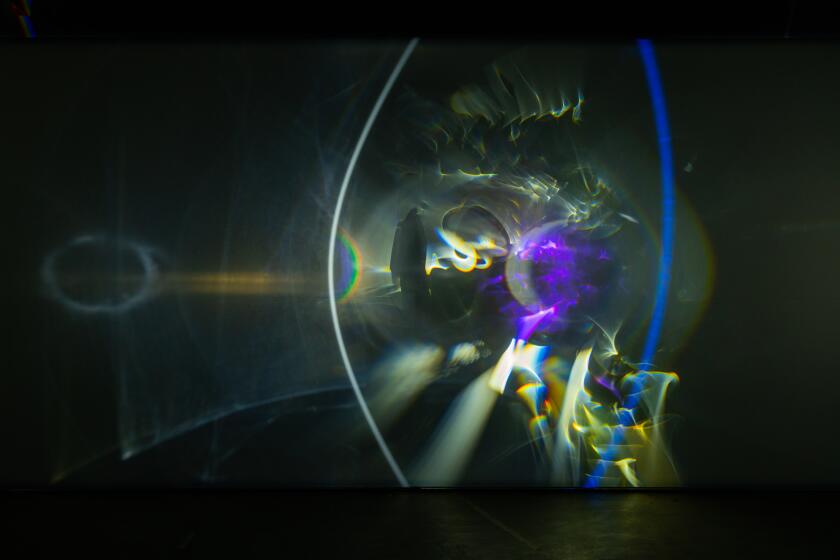This is Gronk’s brain
The lights in the planetarium dim and the theater seats automatically recline so viewers are almost supine, looking up at the domed ceiling. But instead of watching a canvas of the heavens, the audience is taken on a mysterious journey into inner space, led by the experimental performance artist from East L.A. known only as Gronk.
“Welcome into Gronk’s brain and to a powerful new artist medium,” states the promotional material for an unusual, 14-minute animated short film that makes its West Coast debut next Saturday at the Glendale Community College planetarium.
“Gronk’s BrainFlame” visualizes the creative process at a cellular level by entering the mind of the artist at the moment ideas are born. Gronk, known for his dramatic installations and performance pieces, took two years to develop the digital project, considered a cutting-edge experiment in the melding of art, science and technology.
Using 180-degree projection, viewers are drawn into an animated, otherworldly landscape with sprouting pod-like forms and faceless, alien-like figures that move about under a canopy composed of squiggly lines and ambiguous shapes instead of stars and planets.
Gradually, we’re aware of a new shape floating into view from another hemisphere. It starts in the form of a sperm but soon transforms into a brain, with a wiggling, wormy tail that grows until it almost touches the desert-like terrain. Suddenly, one of the creatures is sucked into the stem, winding through a canal in peaceful surrender before exploding into a cavity where his (or her) body falls apart, pieces bouncing off the walls erratically as the sound of sparks suggests the electrical firing of synapses.
Finally, out of the chaos, a piece of art takes shape.
I won’t give away the ending of this brief, wordless drama, previewed for the media Tuesday, because the finale is an ingenious surprise.
A seminal figure in contemporary Chicano art, Gronk burst on the L.A. arts scene during the 1970s as part of ASCO, a guerrilla-style cultural collective whose name means nausea in Spanish. He has worked in a variety of media, including murals, line drawings, set designs for operas and performance paintings produced to the accompaniment of a string quartet, using his brush as a baton. This is the first time he has undertaken a digital project on such a large scale, with a domed canvas stretching 30 feet across.
Gronk originally produced “BrainFlame” at the University of New Mexico’s ARTS Lab, where he was artist in residence. The film premiered two years ago at the LodeStar Astronomy Center in the New Mexico Museum of Natural History and Science, where it was billed at the time as heralding “the emergence of fulldome as an important artistic medium.” He worked in collaboration with ARTS Lab animator Hue Walker, assisted by students from the Digital Pueblo Project, a mentoring program for training in digital art. The film’s surreal but serene musical score is by Steven LaPonsie.
Next week’s West Coast premiere is being co-sponsored by the UCLA Chicano Studies Research Center. The event marks the publication of a new book about Gronk, the inaugural edition of a series titled “A Ver -- Let’s See: Revisioning Art History,” launched by the center to spotlight significant Latino artists whose lives and works remain largely undocumented by the art establishment. The screening will be followed by a reception and book-signing with the artist.
The dome of the 48-seat Glendale planetarium is half the size of the one in Albuquerque where “BrainFlame” was first shown, said Paul Buehler, the local facility’s administrator, but the smaller scale makes for greater clarity and detail in the projection. The venue is also being used for continuing performances of “Spontaneous Fantasia,” a real-time animation display by artist J. Walt who creates images on a computer screen that are projected onto the dome.
In Gronk’s case, the filmmaking process was painstaking. He supervised as many as 40 animators, sometimes guiding a student creating the motion of one object for a few seconds across a flat computer screen. Progress on the finished product could be viewed only in brief segments, sometimes just a minute long. What the audience sees is a movie that has been cut into segments like pie slices assigned to individual projectors, then stitched back together seamlessly on the ceiling.
The glacial, stop-and-go pace of the project posed a challenge for an artist accustomed to working in bursts of spontaneity.
Gronk made a point of avoiding a fast-action, video-game feel to the film. In fact, he emulated the style of silent movies and the primitive special effects of early cinema, as a “tip of the hat to those who have come before.”
Gronk has always resisted being pigeon-holed as a Chicano artist, expected to paint in slogans or depict clichés such as low-riders and cholos. “Don’t tell me who I am,” he says, “tell me who you are.”
So I was surprised when he arrived for a photo shoot at the planetarium wearing a black T-shirt emblazoned with a quintessential Chicano slogan: the letters “c/s” that stand for “con safos.” Though hard to translate, the term is often used as a sign-off by graffiti artists warning others not to mess with their work.
The barrio symbol may telegraph his ethnic identity, with a wink of the eye. But by looking inside Gronk’s brain, you can’t tell what he is.
“I always thought that a living culture is one that experiments and tries new things,” he told me. “A dead culture is one that stays the same. I’d rather be part of a living culture that always has something new for people to view.”
--
West Coast premiere of “Gronk’s BrainFlame,” next Saturday at Glendale Community College, Planetarium and Science Center, 1500 N. Verdugo Road, Glendale. Screenings at 2, 2:30, 3 and 3:30 p.m. Art exhibit and book signing by the artist, 2-4:30 p.m., with a reception catered by Casablanca Mexican restaurant. Screening ticket reservations required; RSVP by Thursday to Bryan Robinson at (310) 825-7716 or brobinson@ support.ucla.edu.
--
Gurza covers Latino music, arts and culture. E-mail him at agustin.gurza@latimes.com with comments, events and ideas for this weekly feature.
More to Read
The biggest entertainment stories
Get our big stories about Hollywood, film, television, music, arts, culture and more right in your inbox as soon as they publish.
You may occasionally receive promotional content from the Los Angeles Times.










